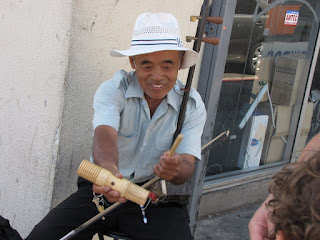Sunday, August 14, 2011
Playing Tourist in LA's Chinatown
What can I say...I used to "cut through" Chinatown on my commute to work everyday for almost a year. I ate there once back in 2002. Have I ever really explored it? Not until today. I'm glad I did. I had fun taking pictures and learning (basically, playing tourist).
Join me on a self-guided tour....with the help of the Interweb...
As early as 1852, a Chinese settlement was recorded near the site of today's Union Station. The community resettled some 86 years later a few streets over, and in 1938, with the dedication of Central Plaza, became the first modern American Chinatown, owned and planned from the ground up by Chinese.
Start your visit at Central Plaza (947 N. Broadway) where you will be enchanted by the quaint walkways and tiny shops. The sound of clicking mahjong tiles can be heard from upstairs windows where many of Chinatown's family associations hold their social meetings. A popular place for filming, Central Plaza with its distinctive "Gate of Filial Piety" also boasts a statue of Dr. Sun Yat Sen, founder of the Republic of China, a wishing well dating to 1939, and a five-tiered pagoda. On the building at 951 N. Broadway, you will find a dragon painted by Tyrus Wong.
A step outside and to the left of Central Plaza brings you to the doorstep of Phoenix Bakery (969 N. Broadway, 213/628-4642). This is the oldest and largest bakery in Chinatown with a citywide reputation for its strawberry whipped cream cakes.
Turn back and walk south along North Broadway. As you pass the curio shops and jewelry stores, stop to take in the beautiful tile murals on the wall at 913 North Broadway. Across the street, note Little Joe's Restaurant, a reminder of the large Italian population that also once lived here. The restaurant has recently been purchased and plans are under way to develop the site and restore the restaurant.
Continuing south, on the left side of the street are Saigon Plaza (a hot mess that felt very much like Bangkok), Chinatown Plaza and Dynasty Center (800 block of North Broadway). Most of the shops and stalls in these bazaars are owned by Chinatown's newest ethnic Chinese immigrants from Vietnam, Cambodia, and Laos.
These bazaars offer real bargains on clothing, toys, food and knickknacks of all kinds. As you walk on the west side of the street your eyes will be caught by a number of jewelry stores sparkling with 18K and 22K gold and exquisite jade creations.
Pit stop for lunch at Hop Louie ...not bad...with $5 lunch specials and an "A" rating...score...
Of course in true LA fashion, lots of celebrities have dined here...
On the corner of Alpine and Broadway is Cathay Bank (777 N. Broadway), the first Chinese American-owned bank in Chinatown. Also on this block is Far East Plaza, considered the first modern ethnic shopping mall in America. Originally a retail plaza exclusively for food, Far East Plaza still houses several restaurants serving styles of regional cuisine that can be found here and nowhere else in Chinatown. It is home to Wing Hop Fung Ginseng and China Products Center (727 N. Broadway, 213/626-7200), the largest store of its kind in Los Angeles, fragrant with herbs and tea, and overflowing with chinaware, garments, arts and crafts. A pharmacy and acupuncturist are located within.
A little detour will take you into another world: an incense-filled Taoist Temple (750 Yale Street). This ornately decorated temple serves as a focal point of the immigrant community and is one of the most beautiful of its kind. As with any religious institution, please be respectful of worshippers and staff on the premises.
By walking or driving back north along Hill Street you will pass the Chinese United Methodist Church (825 Hill Street) which exemplifies a unique blending of Chinese and American architecture dating to the 1940s. The Pacific Alliance Medical Center (931 Hill Street) at the corner of Hill and College streets is one of the first hospitals in Los Angeles. It was built in 1868 to serve the city's French population nearby and boasts a statue of Joan of Arc on the front lawn. Today, the hospital is run by enterprising Chinese doctors and serves the local Chinatown community.
A little further down Hill Street is West Plaza, built in the late 1940s, and mentioned in Lisa See's novel "On Golden Mountain." The F. See On shop at the corner of the courtyard is actually run by See family members. West Plaza houses businesses on the ground floor and residences upstairs. The plaza is also home to a burgeoning new art community whose avant-garde galleries are interspersed among the curio shops.
At the end of North Hill Street, turn right on Bernard Street where you will find the headquarters of the Chinese Historical Society of Southern California (411 and 415 Bernard Street). Both houses were built in the late 1880s by French immigrants. The visitor center showcases artifacts and historical photos recounting the history of the Chinese in Southern California. Call 323/222-1918 for information and Visitor Center hours.
As always...I urge you to get out there and explore the city, town or village you live in!
(Stay tuned for future posts on Chinese fortune telling, Chung King Road and a visit to the Chinese American Historical Society - you know you can't wait)
Subscribe to:
Post Comments (Atom)













No comments:
Post a Comment